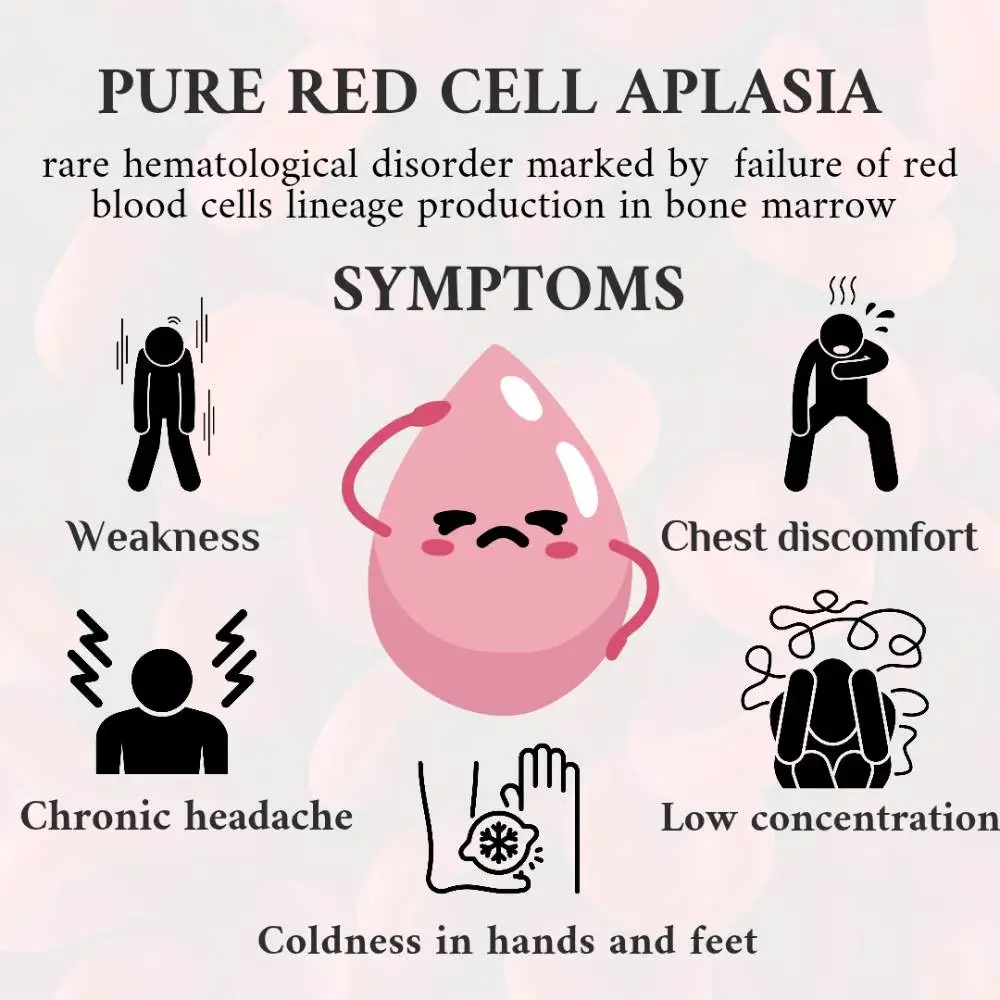Have you ever experienced constant fatigue, heart palpitations, pale skin, or trouble focusing? These symptoms could be a sign of anemia

This condition is known as pure red cell aplasia, and it requires careful awareness and understanding for proper diagnosis and management. Follow along to learn about this rare disorder, including its causes, symptoms, and effective management strategies.
What Is Pure Red Cell Aplasia?
Pure red cell aplasia (PRCA) is an uncommon hematological condition that causes a specific type of anemia, characterized by the failure of red blood cell lineage production, in which the bone marrow shows an absence of erythroblasts, while white blood cells and platelets remain unaffected.
PRCA is not the same as aplastic anemia. In aplastic anemia, the bone marrow stops making all types of blood cells, but in PRCA, it only stops making red blood cells.
What Causes Pure Red Blood Cell Aplasia?
In general, PRCA results from the inability of the bone marrow stem cells to proliferate, differentiate, and survive as normal erythrocytes. This failure occurs due to damage to DNA, lack of essential growth factors, or immune-mediated destruction, depending on the cause.
Therefore, PRCA can be classified into congenital and acquired.
Congenital Pure Red Cell Aplasia
Also known as diamond black fan anemia (DBA), a genetic disorder caused by mutations in ribosomal protein genes, it is usually diagnosed during childhood and may be associated with physical congenital anomalies involving the craniofacial region, limb, or cardiac.
Acquired Red Blood Cell Aplasia
This type of PRCA is represented in adults due to the following mechanisms: –
- Autoimmune disorders often involve antibodies that attack erythroid precursors or erythropoietin. Examples include systemic lupus erythematosus, rheumatoid arthritis, and inflammatory bowel disease.
- Blood cancers or Leukemias, such as:
-
- Chronic lymphocytic leukemia (CLL).
- Large granular lymphocytic leukemia (LGL).
- Hodgkin disease
- Non-Hodgkin lymphoma
- Multiple myeloma
- Solid tumors, such as thymoma (a tumor of the thymus gland), can cause PRCA. Other solid tumors like those of the breast, thyroid, lung, stomach, kidneys, or unknown origin may also be causes.
- Viruses that are associated with this condition, such as parvovirus B19, directly infect erythroid precursors by the P antigen and inhibits their maturation. Other viral infections like hepatitis viruses, HIV, cytomegalovirus(CMV), Epstein-Barr virus (EBV), and COVID-19.
- Bacterial infections include tuberculosis and group C of streptococcus.
- Transplantation of bone marrow can trigger immune-mediated PRCA.
- Nutritional deficiency, such as riboflavin deficiency, may contribute as an uncommon cause.
- Certain medications, such as anti-seizure drugs, erythropoiesis-stimulating agents, immune inhibitors, and certain antibiotics, can halt red blood cell production.
What Are the Symptoms of PRCA Disease?
The symptoms of pure red cell aplasia are linked to anemia, which results from a significant reduction in red blood cell production. The severity of symptoms depends on the degree of anemia and may include:
- General weakness and fatigue due to reduced oxygen transport.
- Pale appearance of the face, lips, and hands.
- Shortness of breath, sometimes even at rest.
- Chronic headaches are caused by insufficient oxygen and blood supply to the brain.
- Chest discomfort or angina, especially in patients with underlying cardiovascular conditions, is due to poor oxygen delivery.
- Low concentration and difficulty focusing as a result of hypoxia.
- Coldness in the hands and feet due to reduced blood flow to the extremities.
- Pulsatile tinnitus, where some patients hear a rhythmic, pulse-like sound in their ears.
Additional symptoms in congenital PRCA such as Diamond-Blackfan Anemia. Signs usually appear before the age of one year and may include:
- Pale appearance with persistent tiredness.
- Congenital anomalies, which are present in around 50% of patients, often affect the craniofacial region, heart, and kidneys.
- Delayed growth was observed in about 30% of patients.
- Characteristic facial features such as wide-set eyes, a snub nose, and triphalangeal thumbs.
- Eye abnormalities, including congenital cataracts and glaucoma.
How Is Red Cell Aplasia Diagnosed?
Diagnosis of pure red cell aplasia requires a combination of clinical assessment, laboratory investigations, and imaging studies as follows:
Clinical Assessment
A healthcare provider assesses signs related to anemia and investigates possible underlying conditions, such as autoimmune disorders, certain medications, infections, or malignancies.
Laboratory Investigations
Several blood and diagnostic tests are recommended to confirm PRCA, including:
- Complete blood picture, which shows normocytic, normochromic anemia with normal leucocytes and platelets counts.
- Reticulocyte count, which demonstrates suppression in the production of erythrocytes.
- A peripheral blood smear that confirms the absence of immature red cells and excludes abnormalities in other blood cell lines.
- Parvovirus B19 PCR for detecting viral infection that can cause PRCA.
- Liver and kidney functions are used to rule out other causes of anemia.
- Immunological tests that identify antibodies directed against red blood cell precursors.
- Bone marrow aspiration to confirm the absence or reduction of erythroid precursors.
Imaging Studies
Imaging studies such as chest x-rays or CT scans may be performed to detect solid tumors or evaluate for thymoma when other causes are not identified.
Additionally, before the diagnosis of pure red cell aplasia, it is crucial to distinguish it from other conditions, such as aplastic anemia, and nutritional deficiencies, such as deficiency of vitamin B12 or folic acid.
Can Pure Red Cell Aplasia Be Cured?
Treatment strategies of PRCA depend largely on the underlying cause and may include the following:
- Immunosuppressive therapy for acquired forms of PRCA which involves corticosteroids combined with other agents. This strategy decreases the relapse rate, though it doesn’t provide a definitive cure.
- Congenital PRCA, that is known as diamond black fan anemia, requires lifelong management through regular blood transfusions and immunosuppressive therapy.
- Thymectomy, or the surgical removal of the thymus gland, may improve symptoms in cases that are associated with thymoma, but it doesn’t completely cure all patients.
- Supportive treatment is often required for managing symptoms over the long term and helps to prevent complications.
In summary, pure red cell aplasia is a rare hematological disorder that is not always curable, but can be effectively managed. The success of treatment depends on the underlying cause and the patient’s response, with continuous monitoring being essential for long-term care.
References
- Mangla, A. (2024, February 24). Pure Red Cell aplasia. From NCBI
- Sawada, K., Fujishima, N., & Hirokawa, M. (2008, August). Acquired Pure Red Cell aplasia: Updated review of treatment. British journal of haematology. From PubMed
- Killeen, R. B. (2025, July 7). Diamond-Blackfan anemia. From NIH
- Pure Red Cell aplasia | blood | From the American Society of Hematology.
- Jr, R. T. M. Update on pure red cell aplasia: Etiology, diagnosis, and Treatment – Hematology & Oncology. From Hematology and Oncology.







